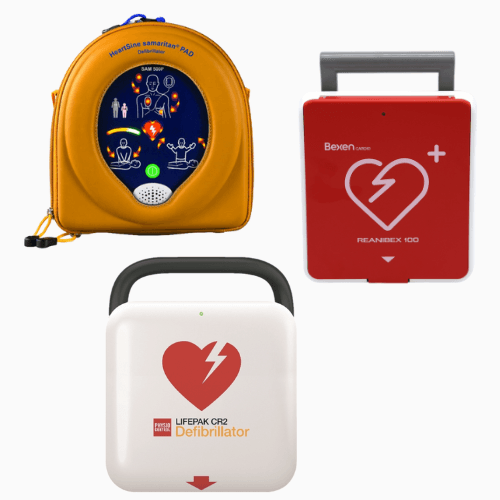
Do you know the difference between a fully and semi-automatic defibrillator?
Not all of our customers do.
I was having a conversation recently with someone who was buying their first defibrillator, or defib as we quickly started saying (its just so much easier!)
Once we’d got past the pronunciation hurdle they were eager to understand how the different models compared. These days, most public defibs come with great features like CPR feedback (telling you how to improve your technique/speed) and child/adult switch (so you don’t have to swap pads manually). That’s great progress, but it can also make choosing the right defib harder, because at first glance they all seem very similar.
But there’s one key difference that really matters: how the shock is delivered.
Do you want a semi-automatic or fully automatic defibrillator?
A Common Misunderstanding
The customer quite understandably assumed that “fully automatic” must mean “better” — because “semi” sounds like it’s only half as good. It’s a common misconception.
In reality, both types are capable of saving lives, both are simple to use, and both are often priced about the same. The difference lies in how they behave when seconds count — and how much control you have in those moments.
So, if you’re unsure which type to choose, here’s a handy guide from the team here at Turtle Medical.
All Defibrillators do the Same Job
Whatever the model, all defibrillators use adhesive pads (electrodes) to analyse the heart’s rhythm and decide whether a shock is needed to restore a normal heartbeat. You don’t need medical training to use one — they’re built to help anyone act confidently in an emergency.
All AEDs feature:
Fully Automatic Defibrillators
If a fully automatic defibrillator detects that a shock is required, it delivers that shock automatically — no button pressing required.
Before doing so, the device announces a warning such as:
“Shock advised. Stand clear. Delivering shock in 3… 2… 1…”
This short delay is designed for safety, giving bystanders time to step back.
However, that delay can be agonising. One user described the 7–8 second wait they experienced as feeling “like a lifetime” — standing over someone in cardiac arrest, knowing a shock is needed, but unable to make it happen faster. When survival chances drop by 10% for every minute without defibrillation, those seconds matter.
This completely automatic system can be of benefit to less confident responders, but each year we see an increase in the percentage of the public in the UK who have completed some form of CPR training. In 2019 the figure was 47%, this figure had risen to 62% just five years later in 2019. Based on this steady rise we can assume that today almost 3/4 of the public have undertaken some form of CPR training, either through education, due to workplace requirements or via community projects/events. CPR and AED use is now a part of the secondary school curriculum, so within a generation we can make sure that everyone knows how to do basic CPR.
With all this in mind, do the public still need a defib that takes away their ability to act quickly in an emergency situation? When every second counts, is there a faster way to save a life?
Let’s take a look at the pros and cons of a fully-automatic defibrillator.
Pros:
• Removes user hesitation — the AED takes full control.
• Ideal for public areas where responders may have no training.
• Simple, stress-free, and fool-proof for untrained bystanders.
Cons:
• The delay before shock delivery can feel painfully long.
• Some people are uneasy about the lack of control.
• Less suited to environments with trained responders who prefer to act decisively.
Semi-Automatic Defibrillators
Semi-automatic defibrillators work almost the same way, except you press the button to deliver the shock after the device advises it.
That’s it: Assess. Push. Shock.
This simple step keeps the responder in control — and removes the waiting. You know exactly when the shock will happen, and you can ensure everyone is clear before delivering it. The device will only recommend a shock if appropriate, so you literally cannot shock by accident. For anyone who has had CPR and AED training, a semi-automatic defibrillator allows them to respond quickly in a life or death situation, ensuring no seconds are wasted.
Pros:
• Keeps the rescuer in control of when the shock is delivered.
• Allows faster treatment — no automatic countdown delay.
• Trusted by first aid trainers, councils, and workplaces.
• Clear, calm voice prompts make it easy for anyone to use.
Cons:
• Some untrained users may hesitate briefly before pressing the button — though prompts help overcome this.
Recommended for:
• 🏢 Workplaces, schools, community buildings, parish councils.
• 🏟️ Sports clubs, community centres, places with trained first aiders.
For most settings, semi-automatic AEDs offer the perfect balance of safety and simplicity — empowering rescuers to act decisively when it matters most.
Which One Should You Choose?
The most important thing of course is that your defibrillator is accessible, visible, and rescue-ready.
But if you were the one lying on the ground after a cardiac arrest, which defib would you want used on you?
Both semi and fully automatic models save lives — but if you want one that gives responders control, confidence AND speed, choose semi-automatic.
Because when every second counts, being able to press that button — and not wait for it — can make all the difference. That’s why here at Turtle we’re proudly Team Semi-Automatic.

